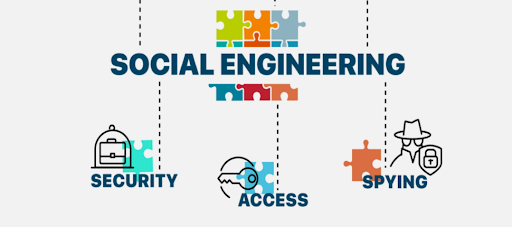Cybersecurity threats continue to be an ever-present danger, and among them, social engineering stands out as a particularly insidious method—often leading directly to phishing attacks. Understanding how social engineering paves the way for phishing is crucial for both individuals and organizations aiming to bolster their defenses.
What is Social Engineering?
Social engineering is a psychological manipulation technique used by cybercriminals to trick individuals into divulging confidential information or performing actions that compromise security. Unlike traditional hacking methods that exploit technical vulnerabilities, social engineering targets the human element, exploiting natural tendencies such as trust, fear, or curiosity.
The Connection Between Social Engineering and Phishing
Phishing is one of the most common and effective outcomes of social engineering. It involves sending fraudulent messages that appear to come from reputable sources, often via email. These messages typically contain malicious links or attachments designed to steal sensitive information or install malware on the recipient’s device.

How Social Engineering Tactics Lead to Successful Phishing Attacks
1. Research and Information Gathering
Cybercriminals begin by gathering information about their targets. This can include details about their job role, interests, and personal connections, often obtained from social media profiles or publicly available databases. The more information they gather, the more convincing their phishing attempts will be.
2. Building Trust
Armed with this information, attackers craft messages that appear legitimate and trustworthy. They might impersonate a colleague, a trusted vendor, or even a senior executive within the organization. By leveraging known relationships and authoritative figures, they increase the likelihood that the target will fall for the scam.
Read more about CEO impersonation
3. Exploiting Emotions and Urgency
Social engineers often create a sense of urgency or fear to prompt immediate action. Phrases like “Your account has been compromised,” or “Immediate action required” are common tactics used to pressure recipients into acting without thinking. This sense of urgency bypasses rational decision-making processes, leading to hasty, ill-considered actions.
4. Call-to-Action
The final step involves guiding the target towards a specific action, such as clicking on a link, downloading an attachment, or providing sensitive information. Once the target complies, the attackers achieve their objective, whether it’s harvesting login credentials, installing malware, or extracting financial information.
Real-World Examples

1. Business Email Compromise (BEC)
A cybercriminal impersonates a company executive and sends an email to an employee in the finance department, instructing them to transfer funds to a specified account. The email appears genuine, complete with the executive’s email signature and writing style, convincing the employee to comply.
2. Spear Phishing
Unlike generic phishing attacks, spear phishing is highly targeted. For instance, an attacker might send an email to a specific individual within an organization, referencing a recent project or event. The personalized nature of the email increases its credibility and the likelihood of a successful attack.
In June 2024, WazirX, one of India’s leading cryptocurrency exchanges, suffered a major cyber attack that significantly impacted its operations and users. Below is a detailed account of the incident:
Initial Breach: The attackers initiated the breach through a sophisticated spear-phishing campaign targeting key WazirX employees. These emails contained malware-laden attachments that, once opened, installed backdoors on the employees’ systems.
3. Vishing
Social engineering, specifically vishing (voice phishing), involves manipulating individuals into revealing confidential information over the phone. Attackers typically pose as legitimate entities, such as banks or government agencies, to create a sense of urgency and trust. They may ask for sensitive details like account numbers, Social Security numbers, or one-time passwords, exploiting the victim’s fear of fraud or other issues.
A real-life example of vishing could involve a scammer calling someone and claiming to be from their bank, warning about suspicious activity on their account. The victim, wanting to secure their account, might share personal details and an OTP (one-time password) received via SMS. The scammer then uses this information to access and potentially drain the victim’s bank account.
To prevent such attacks, individuals should verify callers’ identities through official channels, avoid sharing sensitive information over unsolicited calls, and be cautious of any caller creating a sense of urgency.
Protecting Against Social Engineering and Phishing
1. Education and Awareness
Regular training sessions can help employees recognize and respond to social engineering tactics. Awareness programs should cover the latest phishing techniques, the importance of verifying unexpected requests, and the red flags to watch out for in suspicious communications.
2. Robust Policies and Procedures
Implementing strict policies for handling sensitive information and financial transactions can reduce the risk. For example, any request for financial transactions should be verified through a secondary communication channel.
3. Technical Defenses
Utilize advanced email filtering systems to detect and block phishing attempts. Multi-factor authentication (MFA) can add an extra layer of security, making it more difficult for attackers to gain unauthorized access, even if they obtain login credentials.
Read more about how bad actors might try to bypass MFA
4. Incident Response Plans
Develop and regularly update an incident response plan to ensure swift action in the event of a phishing attack. This should include steps for containing the breach, notifying affected parties, and restoring compromised systems.
Conclusion
Social engineering is a potent tool in the cybercriminal’s arsenal, often serving as the precursor to phishing attacks. By understanding the tactics used and implementing comprehensive security measures, organizations can significantly reduce their vulnerability to these threats.
Remember, in the realm of cybersecurity, the human element is often the weakest link—but with proper training and vigilance, it can also become the strongest defense.









